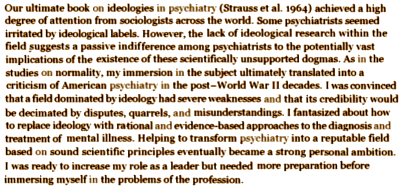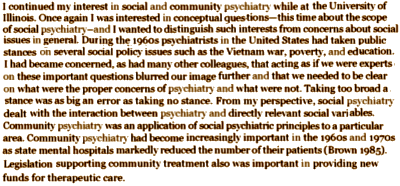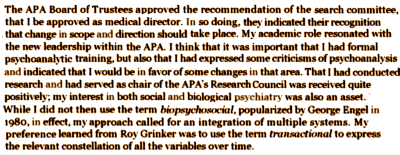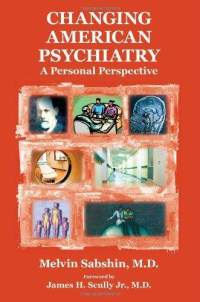In his latest posting he compared the domain of American psychiatry to Yugoslavia. Cast Melvin Sabshin as Marshal Tito. Sabshin was the medical director of the American Psychiatric Association in the late 1970s, the period leading up to DSM-III. Tito and Sabshin each strong-armed a confederation of sorts but failed to deal with the conflicts beneath the surface. Both leaders were faced with the prospect of their domains disintegrating – Tito’s at the hands of Moscow and Sabshin’s at the hands of insurance companies. Both persuaded wary stakeholders to sign on to a compromise, for want of anything better and fearing a worse outcome.The domain of psychiatry hasn’t yet reached the stage of ethnic cleansing and genocide that we saw in Yugoslavia after Tito’s death, but it is well on the way. One only has to look at the vicious response of the American Psychiatric Association leaders to Allen Frances and other critics of DSM-5. The APA president in 2009, Alan Schatzberg from Stanford, went out of his way to smear Dr. Frances and Robert Spitzer, the architects of DSM-IV and DSM-III because he had no credible scientific response to their criticisms of the directions DSM-5 is taking. He was joined in this low act by David Kupfer and Darrel Regier, who are directing the DSM-5 effort. Where is the comity, Comrades? Where are the shared values? Why is the APA holed up in a bunker?
Then we have the unsavory sight of the APA lawyers threatening a blogfrauchen in the U.K. with a SLAPP lawsuit for alleged infringement on the APA’s intellectual property – as though the APA owns psychiatric classification! Talk about chutzpah. So now the confederation Sabshin cobbled together is breaking up and the stakeholders are starting to go their separate ways – psychologists, counselors, social workers, patient advocacy groups, even many psychiatrists. Christopher Lane in Psychology Today has said American psychiatry is facing “Civil War” over its diagnostic manual. Even an international psychiatric journal like British Journal of Psychiatry is distancing itself from DSM-5 and there is talk of abandoning DSM-5 for the next ICD classification.
Why is American psychiatry self destructing? Because the grand bargain forged in 1980 with DSM-III was a sham from the get-go and the promised benefits of diagnostic reliability have not materialized. They knew all along that reliability was a poor substitute for validity, but they settled for half a loaf. That compromise led us into the epistemologic quagmire of today, where there is no solid ground for clinical decisions or clinical research progress or drug development. A stunning absence from the DSMs to date is any statement about treatment. That compromise also led us to diagnostic inflation, which Pharma embraced. Pharma quickly filled the vacuum with experimercials that pretended to be real clinical science, and in the process diverted precious clinical research infrastructure away from genuinely important questions. Just look at the clinical trials er, experimercials, mill operating out of Massachusetts General Hospital at Harvard University…
Mel Sabshin Was Truly a Man for All Seasons
Clinical Psychiatry News
by Allen Frances M.D.
June 28, 2011
For the first two-thirds of the 20th century, Sigmund Freud and Adolph Meyer were the most influential figures in American psychiatry. Then Mel Sabshin picked up the mantle and became the person most responsible for shaping psychiatry into its current form… Mel was appointed medical director of the American Psychiatric Association in 1974. He inherited a mess. Psychiatry was in a confused funk – torn by internal dissension, widely attacked from without, and rapidly becoming irrelevant to the rest of medicine. The smart money would have bet against us. But Mel turned it around. With brilliant [but always unobtrusive] diplomacy and leadership, he was able to integrate the warring elements within the association, pacify the critics from without, and help our profession regain both medical credibility and scientific distinction…Mel also ensured that psychiatry would remain a member in good standing in the medical community. He did everything possible to advance the accuracy of its diagnoses, the efficacy of its treatments, and the strength of its foundation in basic and clinical science. He felt that it was essential that we develop a strong base of knowledge on the epidemiology of psychopathology [and normality], without which our diagnostic system could not achieve credibility. Benefiting from his effective advocacy, psychiatric research funding grew exponentially, so that now, across all medical schools, it is the No. 2 department in terms of National Institutes of Health research funding.
From without, psychiatry was variously attacked for being unscientific, ineffective, stigmatizing, and acting as a tool of the state. Mel soothed the troubled waters by always treating opponents with respect and understanding – often finding unexpected common ground whenever this was possible and being unfailingly cordial when he had to pursue a different agenda. His remarkable diplomatic skills were applied, almost always behind the scenes, across an astounding range of national, international, and professional stages – from Soviet misuse of psychiatry to revolutionizing psychiatric diagnosis to ensuring that effective leaders were successfully recruited and placed in major policy and academic positions. Mel could accomplish so much because he had an almost unique combination of two traits that rarely sort together – he was usually simultaneously both the smartest and yet also the humblest person in the room. Mel was always playing three-dimensional chess while the rest of us were playing Chinese checkers…
When psychoactive drugs were first introduced, there was a brief period of optimism in the psychiatric profession, but by the 1970s, optimism gave way to a sense of threat. Serious side effects of the drugs were becoming apparent, and an antipsychiatry movement had taken root, as exemplified by the writings of Thomas Szasz and the movie One Flew Over the Cuckoo’s Nest. There was also growing competition for patients from psychologists and social workers. In addition, psychiatrists were plagued by internal divisions: some embraced the new biological model, some still clung to the Freudian model, and a few saw mental illness as an essentially sane response to an insane world. Moreover, within the larger medical profession, psychiatrists were regarded as something like poor relations; even with their new drugs, they were seen as less scientific than other specialists, and their income was generally lower.In the late 1970s, the psychiatric profession struck back—hard. As Robert Whitaker tells it in Anatomy of an Epidemic, the medical director of the American Psychiatric Association [APA], Melvin Sabshin, declared in 1977 that “a vigorous effort to remedicalize psychiatry should be strongly supported,” and he launched an all-out media and public relations campaign to do exactly that. Psychiatry had a powerful weapon that its competitors lacked. Since psychiatrists must qualify as MDs, they have the legal authority to write prescriptions. By fully embracing the biological model of mental illness and the use of psychoactive drugs to treat it, psychiatry was able to relegate other mental health care providers to ancillary positions and also to identify itself as a scientific discipline along with the rest of the medical profession. Most important, by emphasizing drug treatment, psychiatry became the darling of the pharmaceutical industry, which soon made its gratitude tangible…



 Here’s the hard lesson of a career as a psychotherapist. There really aren’t that many Angels and Demons walking our streets. Most of us are creatures of our times, schlepping along the best we can – awash in our biographies, our culture, and our piece of history. They have to go out and locate those black and white reality television characters, because they only live in the crevices. I say it’s a hard lesson because it’s so much easier to see people in black and white, or at least in primary colors. That’s why we’re drawn to the simpler characters in our media and fiction – they’re easier to understand, to love, to hate, or to discount. Mel Sabshin had an enormous impact on psychiatry, on psychiatrists, and on our patients. And while I’m mogrified by the current state of psychiatry and a lot of what happened during his tenure, reading parts of his book, I think I would’ve liked him. He was not made of cardboard. I certainly came upon thoughts he had along the way that I’ve had myself. Peeking ahead in the book, Dr. Sabshin responds to many of the criticisms I might level at what transpired, but that’s for another day. I think he felt good about Changing American Psychiatry when the book was published in 2008. But 2008 just happens to be the year of Senator Grassley’s and Paul Thacker’s investigations, and the year I personally mark as the final bursting of a large bubble. Dr. Carroll’s post above ends with:
Here’s the hard lesson of a career as a psychotherapist. There really aren’t that many Angels and Demons walking our streets. Most of us are creatures of our times, schlepping along the best we can – awash in our biographies, our culture, and our piece of history. They have to go out and locate those black and white reality television characters, because they only live in the crevices. I say it’s a hard lesson because it’s so much easier to see people in black and white, or at least in primary colors. That’s why we’re drawn to the simpler characters in our media and fiction – they’re easier to understand, to love, to hate, or to discount. Mel Sabshin had an enormous impact on psychiatry, on psychiatrists, and on our patients. And while I’m mogrified by the current state of psychiatry and a lot of what happened during his tenure, reading parts of his book, I think I would’ve liked him. He was not made of cardboard. I certainly came upon thoughts he had along the way that I’ve had myself. Peeking ahead in the book, Dr. Sabshin responds to many of the criticisms I might level at what transpired, but that’s for another day. I think he felt good about Changing American Psychiatry when the book was published in 2008. But 2008 just happens to be the year of Senator Grassley’s and Paul Thacker’s investigations, and the year I personally mark as the final bursting of a large bubble. Dr. Carroll’s post above ends with:What lies ahead? Stakeholders are going to vote with their feet. DSM-5 is likely to be a footnote in the history of psychiatric classification. The APA will become even less relevant than it is today, much like the American Medical Association, which now commands the loyalty of maybe 30% of U.S. physicians. Mel Sabshin will turn in his grave, the APA will lose revenue, ICD-11 will become the dominant classification of psychiatric disorders, and the quagmire will continue until a new synthesis arises from the ashes. If Yugoslavia is any kind of model, don’t hold your breath.
Wow! What a wonderful overview of the history I have lived through as a psychiatrist.
blogfrauchen!
To vote with their feet, US psychiatrists need to get the APA to change its dues structure so that psychiatrists may belong to their regional associations without paying fealty to an organization that’s done nothing but sell the dignity of their profession down the river.
Proposing this shouldn’t be TOO dangerous to careers….
Very good post. I would be fascinated to read a future post of yours elaborating on the concept of “the final bursting of a large *bubble*”. There seem to be a lot of technological bubbles that have grown and popped, more or less, in the last 30 years. We had biotech, the internet, financial chicanery, etc.
I did my undergraduate and graduate work in business during the 1970’s. This was a great time of change. The old guard of WWII business leaders were giving way to a new younger group. The old guard were use to waiting for their turn at senor positions and were well vetted.
An undergraduate class taught by the sales manager of a drug wholesaler stressed as managers we were the first line of defense against the excess of sales people. Later in graduate school it was all about making your numbers and we had begun to see young managers willing to take any action to accomplish this task.
Supervision was almost all psychology. Positive motivation and meeting the needs of the employee were suppose to be the drivers in the work place. Graduate school was all about breaking down a job to its base parts and then making the employee simply a widget.
The last 30 years have seen the widget model prevail with the law, clergy, and medicine no longer being the three professions, but simply job descriptions. In a world where leadership reflects this attitude can we expect any less from those in the trenches?
Small companies try to stick to the old ways where everyone makes a little while holding onto employees during the bad times are a top priority. Big business laughs at this model with the concept there is only one answer and that answer is yes. Blame the other guy for your failure, and take credit for any and all success.
Universities reflect this attitude with graduates making unrealistic job demands and expecting to be a senor level manager within five years. This all plays into the university’s marketing plan of “selling” education.
I love France and have been fortunate to go every year for over 20 years. The problem is everyone goes to college and as college graduates they simply will not accept any job that is not considered professional. The joke is that all the plumbers in France are from Poland.
We are moving in the same direction with an increased drive that everyone should attend college. The problem is that in true American style we have added a crass twist where leadership feels no responsibility as role models, and they are no better than the door to door siding salesmen of the early 1960’s.
At first be nice, then demanding, and finally abusive all in order to make the sale. Above all else shift the blame for any problems to someone else, including the customer themselves, and make yours while you can.
The DSM-5 will gain traction over time as it plays into the hands of the drug companies and drug companies think in terms of years plural, not as a single number. As I have comment before my personal belief is psychiatry is the business model for pharma. Poor studies accepted by paid for KOL’s that are then foisted onto an unsuspecting public. Add in a hospital industry all too happy to accept new patients and we are all just widgets.
Steve Lucas
Does Australian Psychiatry Matter?
Insel has fingers in Australian Federal Gov. policy.
http://www.alp.org.au:6020/federal-government/news/developing-a-future-vision-for-mental-health-resea/